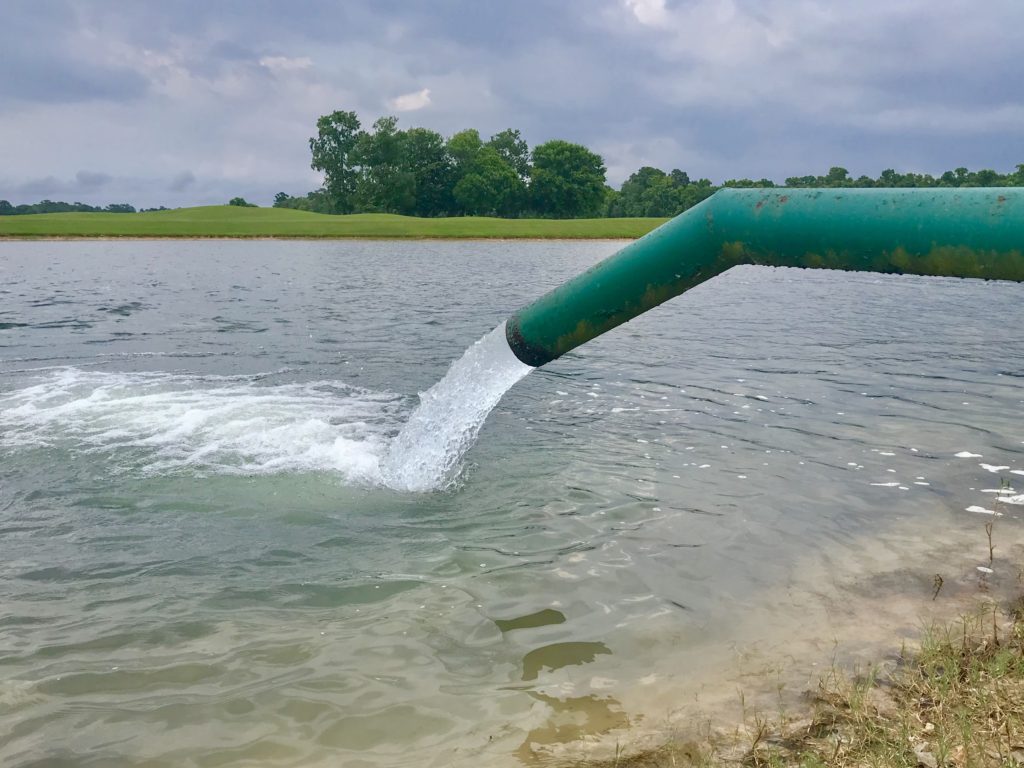
Pumping Water into a Private Lake in Texas
Texas Water Law: A Pond to Call My Own
by Ronald Kaiser
Professor of Water Law & Policy
Texas A&M University
Texas has more than one million ponds and small farm lakes that we call “tanks”. Many were initially constructed for ranching but today most landowners know that a pond or small lake adds both monetary and aesthetic value to their property. A Texas Real Estate Center study indicates that ponds add about $4,500 in value for each of the ponds’ surface acres.
In building a pond landowners must consider location, design criteria and a reliable water supply to insure that a pond is an asset rather than an eyesore and liability. Care must be taken when considering a water source.
Some surface water is owned by the state and landowners must get a state permit before they use it to fill their pond while other surface water is privately owned and no permit is needed. Groundwater is privately owned but if fill your pond from a well you may need a permit from a local groundwater conservation district.
This article briefly discusses the nuances of Texas’ water laws that landowners must navigate in order to avoid legal hassle when filling their ponds.
Public Surface Water
Surface water flowing in a watercourse on your land is state property. If water filling your pond water is diverted from a watercourse, you are taking state owned water and permit issued by the Texas Commission on Environmental Quality may be required. Section 11.021 (a) of the Texas Water Code defines state owned water as:
“The water of the ordinary flow, underflow, and tides of every flowing river, natural stream, and lake, and of every bay or arm of the Gulf of Mexico, and the storm water, floodwater, and rainwater of every river, natural stream, canyon, ravine, depression, and watershed in the state.”
Texas courts refer to state surface water as “water in a watercourse” and they have generally defined a watercourse as drainage way with recognizable banks and a bed capable of carrying a supply of water. The bed and banks maybe slight and water flow need not be continuous but can be intermittent or dry for long periods of time.
A relatively dry, unnamed, natural drainage area may be a watercourse if a current of water sometimes flows through the area in a pattern that is well-defined and relatively static, even though the course may shift over time due to erosion and flooding.
Landowners can consult quadrangle maps provided by the United State Geological Survey (USGS.) for the presence of a watercourse. Perennial and intermittent streams are shown in blue on these maps. However it may ultimately take a hydrologist or an official with the Texas Commission of Environmental Quality (TCEQ), or ultimately a court to determine if surface water is flowing in a watercourse.
The Small Pond Exemption
The Texas legislature has encouraged the development of certain types of small ponds and lakes by exempting landowners from the permit process when they take state water and use it for a specific purpose. It is often called the “stock tank” exemption.
Section 11.142 of the Texas Water Code allows a person, without obtaining a permit from the TCEQ, to construct on their own property a dam, pond or reservoir storing not more than 200 acre-feet of water for domestic and livestock and fish and wildlife purposes.
“An acre-foot is a volumetric unit, it is equal to the volume of water that it would take to fill one acre with exactly one foot of water” On occasion a pond can exceed the 200-acre-foot limitation if its 12-month average is at or below the 200 acre-foot level.
Landowners can lose this exemption if they use the pond for purposes other than domestic and livestock, or fish and wildlife. For example, where landowners decide to use the pond for irrigating a golf course, or for irrigating a cash crop, they must obtain a permit for the new use. Exempt ponds must be used for non-commercial purposes.
The TCEQ has determined that ponds supporting wildlife on property leased for hunting do not constitute commercial uses of the pond.
Another subsection of 11.142 is more lenient allowing landowners in an unincorporated area to construct on their property a pond storing not more than 200 acre-feet of water for commercial or noncommercial wildlife management fish purpose. This exemption does not apply to ponds use for aquaculture and fish farming.
Private Surface Water
Water from rainfall flowing in unpatterened ways across land from higher to lower elevations that have not yet entered a watercourse are called diffused surface water and these waters are the private property of the landowner. Examples of diffused surface water can be found flowing across residential yards or standing in parking lots, baseball diamonds and soccer fields after a heavy rain.
The key distinction is the diffused flow pattern across the land. Since it is private, and not state property, state permits are not require to capture and use diffused water. Nor does the 200 acre-foot limitation does not apply to this water.
So long as they maintain physical control of diffused water in artificial ditches, tanks, ponds, or rainwater harvesting systems, landowners may use it for any beneficial purpose. However, as soon as diffused waters flow into a natural watercourse it becomes state water governed by the Texas Water Code. This applies even if the water flows into a natural watercourse on the landowner’s property.
As a cautionary note, ponds that capture rainwater flowing down a hill may be inadvertently capturing state water if the water flow forms a natural canyon, ravine, gully or channel as it moves down the hill into the pond. Relatively dry, unnamed, natural drainage areas may become watercourses if the flow through these areas is in a pattern that is well defined and relatively static.
GROUNDWATER is privately owned but subject to local regulations
Water percolating beneath the land surface filling the pore spaces of rock and soil material is classified as groundwater. Both the Texas legislature and Supreme Court have determined that landowners have private property rights in the groundwater beneath their land. The only qualification to this rule is that it is must be considered in connection with the law of capture and is subject to regulations by local groundwater conservation districts (GCD’s).
If your property is located in an area not regulated by a GCD no permit is required to pump groundwater to fill your pond. However, landowners cannot waste the water or pump excessive amounts to maliciously harm their neighbor.
Groundwater conservation districts may limit landowner pumping. According to the Texas Water Development Board, 99 local groundwater conservation districts have been established covering 174 of the 254 Texas counties.
Chapter 36 of the Texas Water Code grants GCDs broad authority to manage, conserve, and protect groundwater resources including requiring a permit for any person drilling, equipping, operating, or completing of well, or for substantially altering the size of existing wells or well pumps.
Domestic and Livestock Exemption for Ponds
Chapter 36, Section 117(b) of the Texas Water Code contains a special provision exempting wells from the GCD permit process. This exemption applies to wells pumping less than 25,000 gallons/day provided the water is used solely for domestic use or livestock purposes. Chapter 36 does not define domestic use and each GCD is allowed by rules to craft their one definition of domestic use. A common definition of domestic use adopted by many districts is
“water for drinking, washing, or culinary purposes; for irrigation of lawns, or of a family garden and/or orchard; for watering of domestic animals; and for water recreation including aquatic and wildlife enjoyment and supplying water for private, residential swimming pools. Domestic use does not include water used to support activities for which consideration is given or received or for which the product of the activity is sold.”
Landowners would be well advised to check with their local GCD to determine if a pond filled with groundwater meets the definition of domestic use. So long as the well continues to qualify for exempt well status a GCD may not limit production from that well even during times of drought. This is an important provision for many landowners seeking to keep water in their ponds during a drought.
Summary
After selecting the best location and design landowners should consider the source of the water to fill their pond. Texas law determines source water ownership and landowners must be aware of these rules.
Quite simply, if the pond will be filled with water from a watercourse, a state right water permit may be required. Texas law provides an exemption from the state water permit process for small ponds used for domestic, livestock, wildlife and purposes with less than 200 acre-feet in storage capacity.
Diffused surface water is the private property of the landowner. No permit is required to use this water to fill the pond.
Groundwater is the private property of the landowner but is subject to regulations of local groundwater conservation districts. Texas law provides an exemption from the groundwater district permit process for wells producing less than 25,000 gallons/day that are used to fill ponds used for domestic and livestock purposes.
For more information about Texas Water Law, visit the Texas Water Resources page on the Texas A&M University Website.
